In this issue:
MOFGA has a New Crop Specialist
Leek Moth
Swede Midge
Asparagus Beetle
Oedema
Flea Beetles in Brassicas
Potato Seed Problems
Onion and Cabbage Maggot
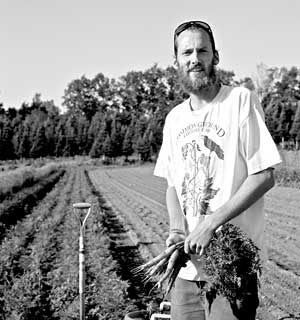 |
| Caleb Goossen |
MOFGA Hires Crop Specialist, Caleb Goossen
I am pulling back to very part time, although I hope to stay on the staff at MOFGA as long as they will have me. The good news is that MOFGA has moved ahead and hired another Crop Specialist. Caleb Goossen has recently completed his PhD at the University of Vermont and we are very glad to quickly grab him to join the MOFGA staff. He started on May 15, so feel free to send him or me growing questions.
Caleb did his graduate work under the direction of many MOFGA friends at UVM, and knows MOFGA and Maine very well (for someone who grew up in Vermont). In addition to studying plant biology and sustainable agriculture as an undergraduate at Hampshire College, and graduate work at UVM studying harvest management practices on forage quality, Caleb has extensive practical experience working on organic vegetable farms. He has worked for many years at Clear Brook Farm in Shaftsbury, Vermont and eventually worked his way up to being field crew leader there before he left to go to get his PhD. He also has experience in some very different systems having worked with organic heirloom seed production and organic orchard maintenance on farms in New Zealand.
We were hoping to find someone with a strong combination of academic and work experience in agriculture, and we are so glad we did. Caleb is going to be a great addition to the MOFGA Agricultural Services staff.
I quickly have asked Caleb to help with the Pest Report. I asked him to discuss two pests, which are not problems here in Maine or New Hampshire YET, but are bound to move east soon from his home state of Vermont, where they are big problems for some growers.
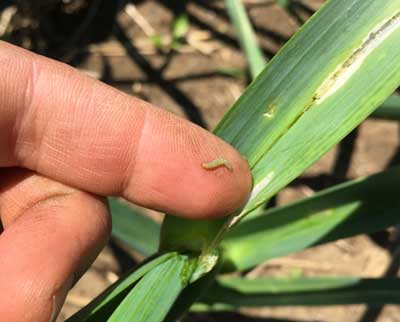 |
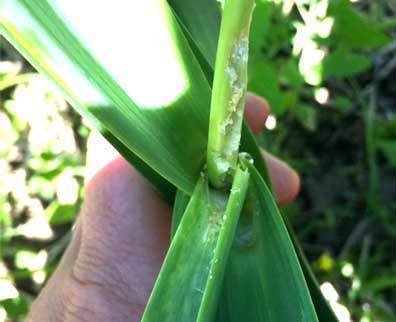 |
|
Leek moth caterpillar |
Leek moth damage |
LEEK MOTH (Acrolepiopsis assectella) – by Caleb Goossen
Leek moth is a newer invasive pest of allium crops like onions, garlic, shallots, chives, and as the name suggests – leeks. First introduced to Canada in 1993, it has been making its way south and east, and was reported in Maine for the first time last year. As with most moth pests the real damage is from its larval caterpillar stage, of which there are two to three generations. Feeding damage first stunts growth as leaves are attacked, and later can impact storage and saleability of onions, garlic, and leeks as the second generation may eat its way in the direction of the bulb. On flat-leaved garlic and leeks, the damage is often visible on the inside surface of the leaf, near the mid-rib, or in the garlic scape.
Damage can also look similar to leafminer damage on onions because the caterpillar chews its way into the circular leaf eating the interior of the leaf but leaving the waxy outer layer intact (‘windowpane’ damage).
Organic control options are limited, though a predatory wasp has been released in Canada. The best practice for now is to use row cover to prevent adult moths from laying eggs on your crop. Row cover can be removed during the day to cultivate or harvest, as the leek moth adult only flies at night.
Keep yours eye peeled for this new pest, and please let us know if you see it. Similar looking damage can occur from onion thrips, salt marsh caterpillar, or simply chlorotic leaf spots from several diseases (e.g., botrytis, purple blotch).
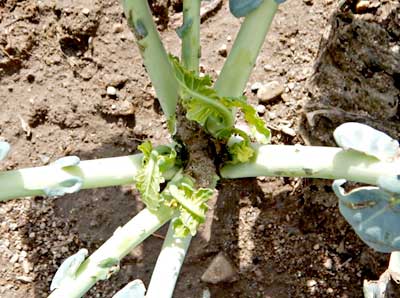 |
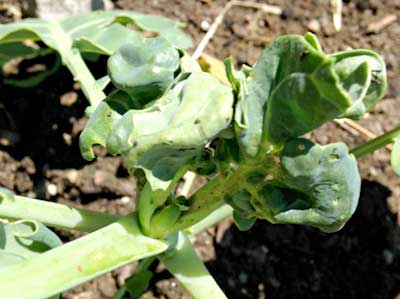 |
| Two views of swede midge damage in broccoli. | Photos courtesy of Elisabeth Hodgdon. |
SWEDE MIDGE (Contarinia nasturtii) – by Caleb Goossen
The swede midge is another new invasive pest spreading south and east from where it was first found in Canada in 2000. These tiny midges are weak fliers, but they can do a lot of damage to brassica crops (broccoli, cabbage, brussel sprouts, cauliflower, etc.) when they get established and their populations build up. Adults lay their eggs near the growth points of brassica crops and the hatched larvae (maggots) feed on the growing tip of the plant. They then drop to the top layers of the soil to pupate, and later emerge as adults to repeat the cycle. This midge is so small and hard to find tucked away in the plant’s growth point, scarring and warped growth from earlier feeding is likely to be the first indication you will find of this new invader. The feeding damage can cause total loss of the primary saleable portion of heading crops (i.e., cabbage, broccoli, cauliflower) or otherwise disfigure new leaf growth.
Organic control options are very limited – the protection of the plant’s overlapping leaves around the growing point shield swede midge from insecticides that would otherwise kill it, and row cover isn’t very effective if they are established and already present in the soil. The best practice for now is to practice crop rotations that are as long (3+ years) and distant as possible (ideally more than 1,000 feet apart), however the midge can also survive on brassica weeds (yellow rocket, wild mustard, pennycress, shepherd’s purse, etc.) so brassica weed pressure has to be taken into account for each field utilized in a rotation.
Please feel encouraged to send photos of unexplained damage in your brassica crops, especially if you are located closer to our borders.
More information can be found at: https://bit.ly/2Glt8ec
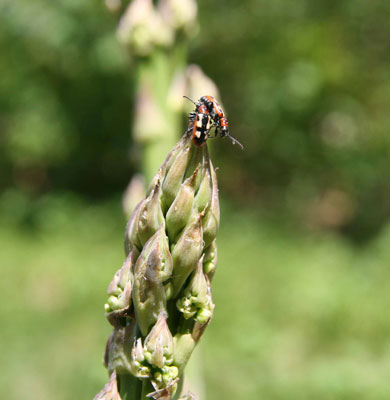 |
| Common asparagus beetles |
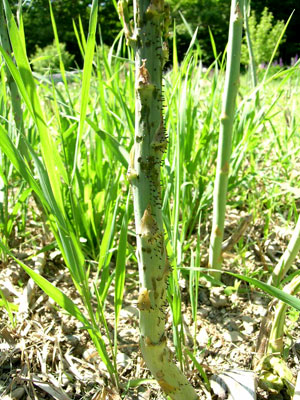 |
| Common asparagus beetle eggs on an asparagus spear |
ASPARAGUS BEETLE, COMMON AND SPOTTED
First Let Me Discuss Frost
One of the very first questions I received when I began working for MOFGA many, many years ago turned into an argument. Not a good start for my tenure, but I stuck it out. The guy who called would not believe me that asparagus is frost sensitive. His spears had turned dark, wrinkled and water-soaked. I don’t know if I ever convinced him that the problem was they were frosted. Perhaps he is reading this.
Asparagus, despite its status as a primo early season vegetable, is highly sensitive to frost, ranking alongside cucumber, snap beans, eggplant and tomatoes in the ‘most susceptible’ category. There is still a chance of frost.
When frosted, spears appear slightly darker green, water-soaked and break off easily. Thawed spears become mushy. Soft-rotting bacteria can enter the damaged tissue. New spears take several more days to emerge, but will. Temperatures below 33 degrees Fahrenheit may damage the spears.
The Beetles
I have seen both kinds of asparagus beetles here already. Usually the spotted asparagus beetle becomes active somewhat later in the spring, and in my experience is less common (I guess with the names that is not a surprise). These two beetles are closely related and have similar life cycles, but it is the common asparagus beetle that is most damaging to the spears.
Common asparagus beetle(Crioceris asparigi) is blue-black, shiny, smooth and about 6 to 9 mm (1/4 inch) long, with three large yellow, squarish spots with red margins along each wing cover. Eggs are black, laid standing on end in rows along the spears, and hatch in 3-8 days. Larvae are wrinkled, plump, hump-backed, and dull gray with black head and legs. Some people call them “worms”. They grow up to 1/3 inch. These larvae feed in spears and in ferns. The larvae do the most damage, and eggs and larval damage makes spears unmarketable. Larval feeding can cause severe defoliation and weaken the stand. When full grown, larvae drop to the soil and pupate underground. New adults emerge in July, feed in ferns, and by September are looking for overwintering sites. Both species spend the winter as adult beetles either in field borders or within the asparagus field. Sheltered sites such as under bark or in the stems of old plants are preferred. Some burrow into the soil.
Spotted asparagus beetle(Crioceris duodecimpunctata) is reddish orange or tan, with six black spots on each wing cover (hence its other name, 12-spotted asparagus beetle). Eggs are greenish, glued singly on their sides to leaves. Eggs are laid on fronds, not on spears. Larvae are similar to those described above, but are orange colored, and feed almost entirely inside the berries so they affect seed production but do not hurt the plants.
Cultural Controls
During harvest, you can greatly reduce the population by harvesting ALL of the ready spears every harvest. Do not allow any spears to develop into fronds until you are all done harvesting for the season. This reduces the number of stems where eggs will survive, and larvae can feed and grow up into the summer-generation beetles.
In the fall remove all of the crop residue and other refuse nearby that provides shelter for adults over winter. Maintaining a clean environment in the fall will force beetles to seek shelter outside the field or burrow in the soil, where many predators reside.
Biocontrol
The most important natural enemy of common asparagus beetle is a tiny parasitic wasp (Tetrastichus asparagi) that attacks the egg stage. Wasps kill eggs by feeding on them (sucking them dry), and also lay their own eggs inside the beetle eggs. The immature wasps grow inside the beetle larvae, killing them when they pupate. Studies have found >50% of eggs killed by feeding and half of the surviving larvae parasitized. Providing a nearby nectar source such as umbelliferous flowers may enhance wasp populations.
Monitoring and Chemical Control
Scout fields regularly. You may want to treat spears if >10% of the plants are infested with beetles. The daily harvest makes treatment difficult because few want to spray anything close to harvest time. Treating infested fronds is important. Organic options include Entrust (Monterey Garden Spray for gardeners). Surround WP may work as a repellent.
Thanks to: Ruth Hazzard (U. Mass Vegetable Notes & The New England Vegetable Management Guide), and Brian Caldwell, Cornell University
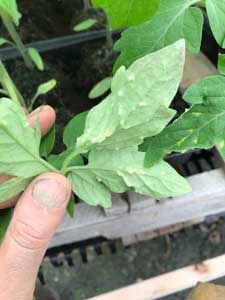 |
| Oedema on tomato |
OEDEMA (EDEMA)
I often get calls this time of year from folks who fear they have a disease on their tomatoes, or related crops such as tomatillo. It is also a common problem in plants in the cabbage family, and some house plants. They see blisters or bumps on the surface of the leaves, most often the underside. The swellings initially appear pale-green, but they can erupt and turn yellow, brown or even black. Eventually, corky spots appear on the underside of the leaves. Older leaves are more often affected than younger leaves.
Oedema is not a disease caused by a pathogen, but rather is a physiological disorder that develops when a plant absorbs water faster than it can be lost from the leaf surface. Excess moisture builds and the blisters form. This is most commonly induced when transpiration is limited. Transpiration (the natural loss of water from the plant) is reduced by cloudy days, humid conditions in a greenhouse, cool temperatures, low light levels such as when plants are raised on a windowsill in a home, etc. Overwatering under these conditions is commonly the biggest factor causing the problem.
Leaves affected with edema never clear up, but there are steps to be taken to prevent more of the problem:
• Cut back on watering when conditions favor edema, but, of course, do not let the plants completely dry out.
• Water only in the morning
• Increase the light if it is low
• Increase ventilation and avoid over-crowding plants
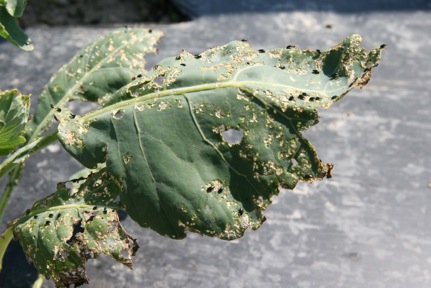 |
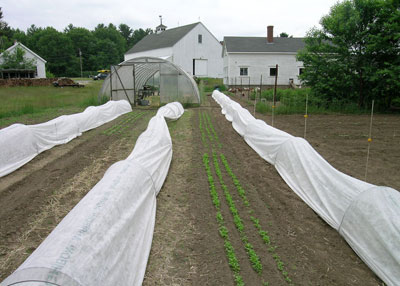 |
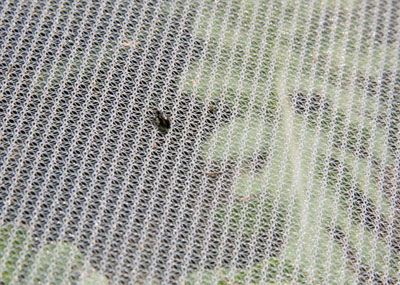 |
| Flea beetles on broccoli leaf | Row covers | Flea beetle trying to get through Proteknet. (www.duboisag.com/en/proteknet-insect-netting.html) |
FLEA BEETLES IN BRASSICAS
Flea beetles are busy feeding in spring plantings of brassica crops in Massachusetts, and just beginning here in the north. Numbers are likely to rise in coming weeks here in Maine as beetles move out of field borders where they spent the winter. Crucifer and striped flea beetles feed on Brassica crops as well as weeds that are in the same family, such as yellow rocket or wild mustard. [It is a different species of flea beetles that feeds on the tomato family of crops. This is important information when planning rotations of potatoes or tomatoes with Brassica cash or cover crops].
The crucifer flea beetle (Phyllotreta cruciferae) is uniformly black and shiny, about 2 mm in length, while the striped flea beetle (Phyllotreta striolata) has two yellow stripes on its back. Flea beetle adults feed on leaves and stems, resulting in numerous small holes, or ‘shot-holes’. Eggs are laid in the soil starting in late May, and beetle larvae feed on roots. The non-waxy greens (arugula, bok choi, tatsoi, mustard, Chinese cabbage, komatsuna) are preferred to the waxy cabbage, kale and collard types of brassicas. In brassica greens, beetles feed on the whole surface of the leaf, and will continue feeding from the seedling stage until harvest. Waxy crops are most susceptible at the cotyledon and seedling stage and feeding is more limited to leaf margins on older plants. Some crops simply out grow the beetle pressure and the damage can be tolerated. No damage can be tolerated in crops such as arugula.
To reduce and delay flea beetle invasion of spring crops, move them as far away as possible from the fields that were used for Brassica crops last fall. Beetles overwinter in field borders near last year’s crop. Planting the same crop close by to where it was last year ensures a high population in the spring. The same could be true if you have fields full of mustard weeds.
One of the best ways to protect Brassica crops from flea beetles is to place a floating row cover over the bed or row. It is critical to seal the edges immediately after seeding or transplanting, because Brassica seeds germinate quickly and beetles rapidly find the cotyledons. Flea beetles can fit through extremely tiny cracks. Edges of the cover must be sealed on all sides using soil, plastic bags filled with soil, or some other method.
Spinosad (Entrust is organic formulation for farmers, and Monterey Garden Spray is one for gardeners) is proving to be effective in suppressing flea beetles and reducing damage. Pyrethrin (Pyganic EC 5) showed poor to moderate efficacy in trials, and has a short residual period. Yet some growers have reported a good knockdown with this product. You can spray right through the floating row covers and knock down any flea beetles that may have gotten inside. I hear that there is work going on now testing beneficial nematodes, and Caleb and I will keep you informed as we hear more.
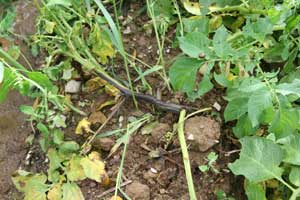 |
| Dicheya blackleg on potato |
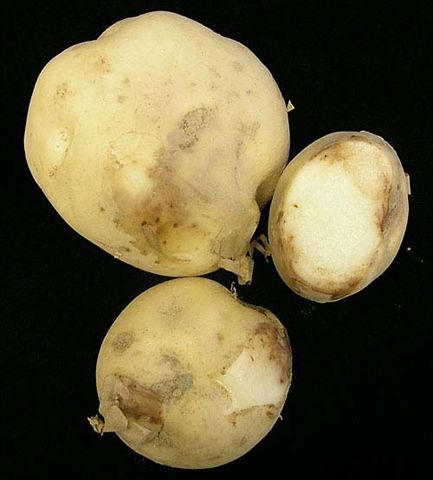 |
| Late blight on potato tubers |
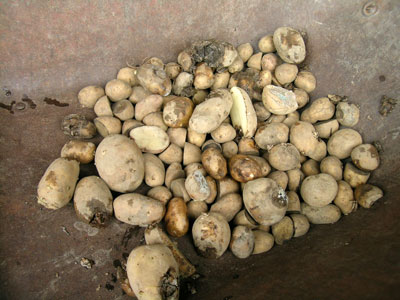 |
| Fusarium dry rot on potatoes. |
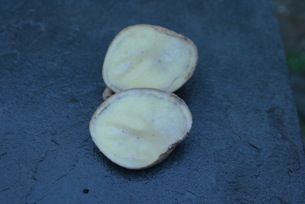 |
| Ring rot on potato |
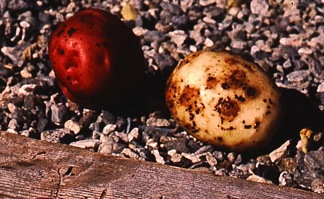 |
| Black scurf on potatoes |
POTATO PLANTING TIME: DON’T PLANT A PROBLEM
Potato seed tubers are often the source of infection for your crop, and so inspection before planting is well worth the time. Some problem seed pieces are not going to spread a disease and can be planted. Others should never be planted. Here are some common issues.
Dickeya is a new disease in the USA, a type of blackleg. It is caused by a bacterium (Dickeya dianthicola). It is spread by planting contaminated seed. The disease does not survive in the soil long, and so the major way it spreads is by seed. Be sure to buy certified seed, although it seems that there is not yet a sure fire test. For the whole story, see https://vegetablemdonline.ppath.cornell.edu/NewsArticles/Potato-Dickeya.html
Late Blight – Look at the picture if you don’t know what this looks like. If you are not sure, check with an expert. Besides taking down your potato crop, planting potato seed carrying late blight is the most likely source of a community or state wide problem. Do not plant any potatoes suspected of being infected with late blight.
Fusarium Dry Rot – This is probably the greatest cause of loss in storage. It is also the most common problem seen on seed pieces. It can result in seed piece decay after planting and result in uneven stands. A slimy rot often develops when Fusarium dry rotted potato seed is planted. This is a secondary infection by bacteria, which take over. Do not plant seed pieces with Fusarium dry rot.
Ring Rot – This is one of the worst diseases you can get on your farm because once you get it, it is very hard to get the farm clean again, and it spreads very easily by the bacteria clinging to boots, crates and equipment. Check your seed carefully and discard the whole load if any ring rot is found. In the tuber you will see the disease as a break down of the ring of vascular tissue when you cut the potato. Squeezing the tuber will expel creamy, odorless ooze of bacteria. Planting these tubers will introduce the bacteria to your soil.
Scab – Lesions on the tuber are usually circular and seldom larger than a half inch, but in very bad infections they coalesce. They may be a cork like layer or pitted. The layer under the lesion is straw colored. Planting these tubers will introduce the bacteria to your soil. If this is a regular problem for you, choose scab resistant varieties.
Black Scurf – If you have little black, irregular lumps on the skin of your potatoes that resemble soil but will not wash off, then you have black scurf. This is a disease that is caused by a fungus called Rhizoctonia solani. The black specks are one of the ways the fungus reproduces. They are called sclerotia, which are tight, dry masses of fungal tissue (mycelium) in a resting phase. In the spring the sclerotia germinate and infection of the new potatoes begins. Most commonly, infection of potatoes is from planting potato seed pieces with sclerotia on them, or having done so years ago. Crop rotation is not very effective because sclerotia can survive for many years without a host crop. So, avoid ever planting seed with the disease.
Hollow Heart – Just as the name implies, the center of the potato is hollow. It appears as splitting within the tuber. The inner wall of the hollow part may be white, tan or may be infected with a secondary disease. Hollow heart is not caused by a pathogen but rather by rapid tuber enlargement especially after a period of moisture stress. Potato seed with hollow heart will not spread the disease.
Knobby potatoes – Potatoes with knobs are usually the result of high field temperature and drought or other conditions that cause irregular rates of tuber development. Planting knobby potato seed will not spread the problem.
CABBAGE AND ONION MAGGOT– Reprinted and modified from Umass Veg Notes
Onion maggot (Delia antiqua) and cabbage maggot (Delia radicum) flies look nearly identical but are likely to be found only on or near their host crop. Last week I discussed the seedcorn maggot, which is the earliest of the vegetable crop maggots. Now the onion and the cabbage maggots are becoming the concern. Cabbage root maggot attacks all types of Brassica crops, while onion maggots are highly specific for the onion family including onions, garlic, leeks, chives, and shallots. A good indicator of the start of cabbage root maggot flight is blooming of the common roadside weed, yellow rocket.
Life cycle: Onion and cabbage maggot flies spend the winter as small brown pupae in the soil. Adults emerge in spring and adults can travel considerable distances in search of host plants (1/2 to 1 mile). Cabbage root maggot flies are rather delicate, hump-backed gray-brown flies, about 5-7 mm long. Onion maggot flies are very similar. Female flies seek out their host crop to lay eggs at the base of the stem. Cool, moist soil conditions favor survival of the eggs, and soil temperatures over 95 F kill them. When the soil temperatures in the upper half to 1 inch are high (>100 degrees F) that soil temperature itself then provides control. This is the reason these pests are much more of a problem in the spring and summer generations of the pest are rarely noticed.
When eggs hatch, larvae feed on roots and can cause complete destruction of the root system. In crops such as broccoli or cauliflower the first sign of a problem is wilting of the plant on sunny days and yellowing of outer leaves. Later, plants collapse, wilt down, and die. If you pull one up you will see that the reason it is wilting is the roots are gone. You may find the legless white maggots feeding, or the small brown, oblong pupae. In Brassica root crops such as turnips, radishes and daikon, feeding tunnels make the root unmarketable.
In onions, newly hatched larvae crawl behind the leaf sheath and enter the bulb, and feed on the roots, stem, and developing bulb. Feeding damage also encourages entry of soft rot pathogens.
Avoiding damage by later planting. The first flight and egg-laying period is generally most intense in the first half of May in Mass., depending on accumulated growing degree days – thus, it will vary with the season and location. After the first flight is over, and as soils heat up, fewer eggs are laid and those that are laid are less likely to survive. I have observed that in most years that Brassica transplants set out after the flowers fall from forsythia did not suffer damaging infestations of cabbage maggots. In cooler areas of the state, however, scouting has sometimes found damaging levels into June. Each season will be different. It is impossible to name a consistent and reliable date after which it is safe to plant onions or cole crops, but late May into June will likely be safer than the first half of May. So, if you are seeing damage, there is still time to do another planting of onions and be less at risk. And, there is time for many more plantings of brassica crops.
Monitoring – Flies are attracted to bright yellow colors. Yellow sticky cards (3X5 inches) are inexpensive and easy to use; attach them with small wire stakes and place near the soil. Check and change traps twice weekly to record changes in fly activity. Sources: Great Lakes IPM, Gemplers
Using Growing Degree Days – The beginning and peak of each fly generation can be forecasted using degree day accumulations. Most growing degree day information for plants and insects is based on a base temperature of 50 F, but maggot flies are active at a lower base temperature of 40 F. For more information on using growing degree days, go to https://www.umassvegetable.org/ and look at the May 6, 2010 issue of the Umass Newsletter. Or, go the the NEWA weather site, which probably has a station near you. It is a cool interactive map for you to find a site near you, and then see the GDD accumulated: https://newa.cornell.edu/
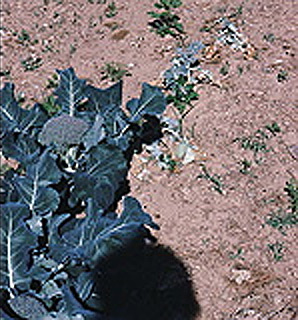 |
| Cabbage maggot damage on broccoli: The row cover was about 10 feet too short and the cabbage maggot got the last few plants! |
Control
Floating row covers provide an effective barrier against these pests. Place the cover on as soon as the transplants are set. Use in a rotated field, as flies overwinter in soil after late season crucifers and could emerge under the cover if the same field has spring brassicas. Replace cover after weeding operations. As soil temperatures rise, the first flight ends and crops grow large, covers can be safely removed.
Crop rotation contributes to keeping populations low; greater distances are more effective. Fall tillage to bury crop residues and to expose over-wintering pupae is also important. For onions, bury or haul away onion cull piles. Rotting onion smell attracts the onion maggot fly. In an vigorous Brassica crop, cultivation that brings soil up around the stem may help encourage formation of adventitious roots from the stem, which can help compensate for root loss even if maggots are present.
Naturally-occurring fungal diseases occasionally will reduce onion maggot numbers significantly, particularly when flies are abundant and relative humidity is high. During a fungal epidemic dead, diseased flies, can be seen clinging to the highest parts of plants along field edges. Predaceous ground beetles, which eat onion maggot eggs, larvae and pupae, can also be important in reducing maggot numbers.
Nematodes for biological control. One alternative method that has shown promise but has not been widely field-tested is soil application of entomopathogenic nematodes, especially Steinernema spp. Steinernema feltiae has been found to be more effective compared to other Steinernema or Heterorhabditis species in attaching to and penetrating cabbage root maggot larvae at low temperatures (10C) which is an important trait for use in spring when soils are cold. Common application methods include suspension of nematodes (infective juveniles) in water and application of water to transplants prior to setting in the field (as a spray or soaking drench), in transplant water used in the water wheel transplanter, as a drench after transplanting, or a combination of pre-plant and post-plant applications. Rates of 100,000 to 125,000 infective juveniles per transplant have been shown to be needed to achieve reduction in damage.
Some Beneficial Nematode Suppliers:
IPM Labs: https://www.ipmlabs.com or 315-497-2093
Arbico Organics: https://www.arbico-organics.com or 800-827-2847
Griffin Greenhouse Supplies: 978-851-4346 or www.griffins.com
Integrated Biological Control Systems: 888-793-4227 or www.goodbug-shop.com
Koppert Biologicals: 800-928-8827 or www.koppert.com
Thanks to Ruth Hazzard. References:Network for Environment and Weather Applications (NEWA) of NYS IPM Program; Ontario Ministry of Agriculture, Food and Rural Affairs online fact sheet; Schroeder et al 1996, Journal of Economic Entomology 89:1109-1115; Chen et al, 2003, BioControl 48: 713-724
